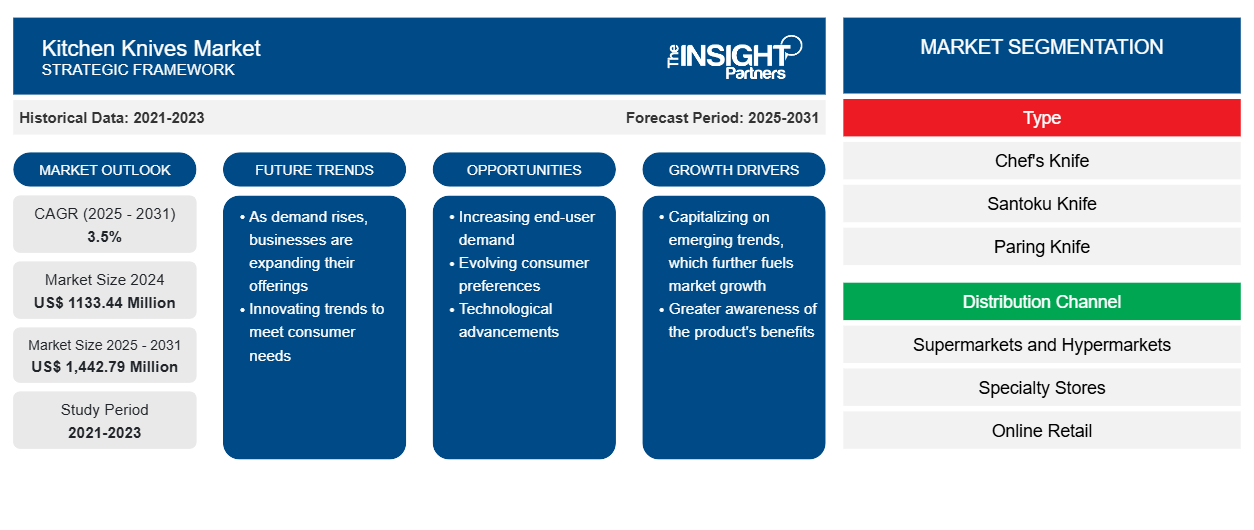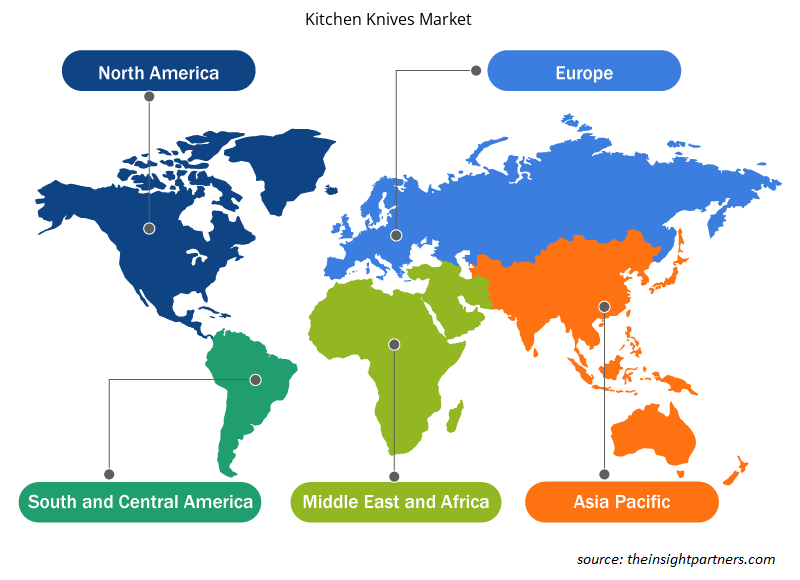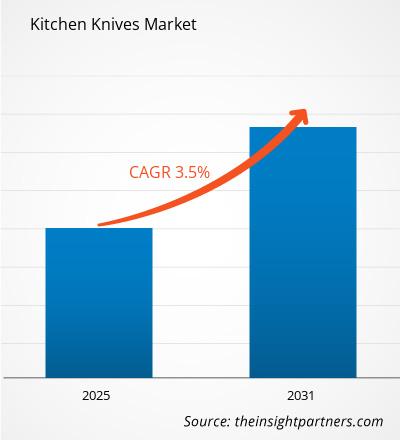The kitchen knives market size is projected to reach US$ 1,442.79 million by 2031 from US$ 1,095.11 million in 2023. The market is expected to register a CAGR of 3.5% during 2023–2031. There is an increase in the demand for customized and personalized kitchen knives. The users are looking for functional knives customized according to their needs. The popularity of cooking as a hobby is increasing with time. The demand for high-quality, visually attractive kitchen utensils is the reason behind the development of custom kitchen knives.
Kitchen Knives Market Analysis
There is growing interest in cooking and a desire for precision and efficiency. Consumers are looking for knives that are sharp, long-lasting, and comfortable to use, with prefer knives with features such as ergonomic handles and precision blades. Manufacturers are adapting to this trend by creating innovative products to cater to their customers' needs. These factors are driving the kitchen knives market. Technological advancements such as ultrasonic kitchen knife provide superior cutting performance, universality, simple operation, comfortable usage, and easy portability. This technological advancement in Kitchen Knives allows the kitchen knives market to grow.
Kitchen Knives Market Overview
The kitchen knives market is projected to be driven by people's augmented interest in cooking, the extending popularity of cooking shows and social media, transforming consumer preferences, and increasing demand for premium and innovative products in consumer goods such as kitchen tools, including kitchen knives. Moreover, advancing disposable income increased demand for premium and innovative products. Consumers are inclined to spend better on high-quality kitchen knives with exceptional performance, durability, and comfort. Knives are crucial kitchen tools that offer myriad advantages over regular knives, such as ease of use, efficient chopping & slicing, and adequate control. The growing number of people choosing cooking as a career and embracing cafeterias in schools, colleges, and workplaces have contributed to the increasing usage of kitchen knives. Kitchen knives manufacturers even focus on producing long-lasting, safer, and affordable products, expanding sales of kitchen knives. The increasing popularity of street food and the growing number of restaurants have also fueled demand for kitchen knives, with many chefs picking to use them over traditional knives.
Customize This Report To Suit Your Requirement
You will get customization on any report - free of charge - including parts of this report, or country-level analysis, Excel Data pack, as well as avail great offers and discounts for start-ups & universities
Kitchen Knives Market: Strategic Insights

- Get Top Key Market Trends of this report.This FREE sample will include data analysis, ranging from market trends to estimates and forecasts.
Customize This Report To Suit Your Requirement
You will get customization on any report - free of charge - including parts of this report, or country-level analysis, Excel Data pack, as well as avail great offers and discounts for start-ups & universities
Kitchen Knives Market: Strategic Insights

- Get Top Key Market Trends of this report.This FREE sample will include data analysis, ranging from market trends to estimates and forecasts.
Kitchen Knives Market Drivers and Opportunities
Increasing Focus on Premium and Artisanal Kitchen Knives
Consumers are looking for premium and innovative kitchen knives that offer superior performance, durability, and convenience. This is driving manufacturers to develop new and improved products to meet consumer demand. The innovative use of ceramic in manufacturing knives has further increased their consumption, owing to their ability to resist the effect of acidic or juicy surfaces, be rust-proof, and retain sharpness for longer. Leading manufacturers are developing improved products because consumers demand premium kitchen knives with superior performance, convenience, and durability. Knives made up of ceramics resist acidic and juicy surfaces, have long sharpness retention and rust-proof properties, and have increased consumption due to their convenience and superior performance. These factors are driving the growth of the kitchen knife market.
Increasing Demand for the Unique Shapes and Sizes
There is a significant increase in consumer preference for products that are unique in shape and size. The increasing demand for these products stands out due to their ability to differentiate themselves and offer the customer personalization. Furthermore, the increase in social media usage and the need for shareable content and products with unique and customizable shapes and sizes, are grabbing the attention and creating buzz in the market. As a result, major companies focus on creating products that cater to this opportunity, offering greater variety and customization to consumers.
Kitchen Knives Market Report Segmentation Analysis
Key segments that contributed to the derivation of the XYZ market analysis are type and distribution channel.
- Based on type, the kitchen knives market is segmented into Chef's Knife, Santoku Knife, Paring Knife, Bread Knives, Knife Sets, and Others.
- In terms of distribution channels, the kitchen knives market is segmented into Supermarkets and Hypermarkets, Specialty Stores, Online Retail, and Others
Kitchen Knives Market Share Analysis by Geography
The geographic scope of the kitchen knives market report is mainly divided into five regions: North America, Asia Pacific, Europe, Middle East & Africa, and South & Central America.
Europe dominated the global kitchen knives market. The European kitchen knives market is primarily driven by the region's substantial culinary practices and heightened demand for high-quality kitchen appliances and tools. Considerable European consumers are keen to invest in high-end kitchen knives for experienced and home use, further surging the market growth in the region. Moreover, the rising popularity of cooking shows and culinary tourism in the region contributed to the rising product sales. The region's focus on sustainability and eco-friendliness drives the expansion of innovative kitchen knife materials such as high-carbon stainless steel, a laminate of carbon and steel metals, or ceramic designs that are environment-friendly and more sustainable.
The Asia Pacific is expected to account for the fastest kitchen knife market growth. This is due to the growing tourism initiative, the rising number of food outlets, cafes, and hotels, and the rising easy availability of kitchen knives in residential houses. The tourism sector in the Asia Pacific has been undergoing rapid growth for the past few years, with multiple visitors coming from different parts of the world to explore the region's myriad cultures and cuisines. This factor increased food outlets, including hotels, restaurants, and cafes, further driving product demand, such as kitchen knives. In addition, the increasing number of fast-food outlets in Asia is essential in the growing demand for kitchen knives. Fast-food cafes need efficient and durable kitchen tools for food preparations, and kitchen knives are one of the essential tools for their daily operations during cooking, which drives the kitchen knives market growth.
Kitchen Knives Market Regional Insights
The regional trends and factors influencing the Kitchen Knives Market throughout the forecast period have been thoroughly explained by the analysts at Insight Partners. This section also discusses Kitchen Knives Market segments and geography across North America, Europe, Asia Pacific, Middle East and Africa, and South and Central America.

- Get the Regional Specific Data for Kitchen Knives Market
Kitchen Knives Market Report Scope
| Report Attribute | Details |
|---|---|
| Market size in 2024 | US$ 1133.44 Million |
| Market Size by 2031 | US$ 1,442.79 Million |
| Global CAGR (2025 - 2031) | 3.5% |
| Historical Data | 2021-2023 |
| Forecast period | 2025-2031 |
| Segments Covered |
By Type
|
| Regions and Countries Covered | North America
|
| Market leaders and key company profiles |
Kitchen Knives Market Players Density: Understanding Its Impact on Business Dynamics
The Kitchen Knives Market market is growing rapidly, driven by increasing end-user demand due to factors such as evolving consumer preferences, technological advancements, and greater awareness of the product's benefits. As demand rises, businesses are expanding their offerings, innovating to meet consumer needs, and capitalizing on emerging trends, which further fuels market growth.
Market players density refers to the distribution of firms or companies operating within a particular market or industry. It indicates how many competitors (market players) are present in a given market space relative to its size or total market value.
Major Companies operating in the Kitchen Knives Market are:
- Friedr Dick GmbH and Co
- Global Knives
- KAI USA Ltd
- KIYA and Co Ltd
- Masamoto Sohonten Co Ltd
- Mercer Tool Corp
Disclaimer: The companies listed above are not ranked in any particular order.

- Get the Kitchen Knives Market top key players overview
Kitchen Knives Market News and Recent Developments
The kitchen knives market is evaluated by gathering qualitative and quantitative data post primary and secondary research, which includes important corporate publications, association data, and databases. A few of the developments in the kitchen knives market are listed below:
- ProCook launched a limited-edition version of their Professional X50 Chef range for the festive season. The set features ash wood handles in warm ochre tones and brass rivets on each knife. It's a unique gift for foodies and discerning shoppers, blending traditional French knife styling with modern flair. (Source: ProCook, Newsletter, OCT 2023)
- Caraway secured $35 million in VC funding last year to expand its product range, including prep tools and a storage system, aiming to dominate the kitchen market. A collection of prep tools includes knives, spatulas, and cutting boards. (Source: Caraway, Newsletter, AUG 2023)
Kitchen Knives Market Report Coverage and Deliverables
The “Kitchen Knives Market Size and Forecast (2021–2031)” report provides a detailed analysis of the market covering below areas:
- Kitchen knives market size and forecast at global, regional, and country levels for all the key market segments covered under the scope
- Kitchen knives market trends as well as market dynamics such as drivers, restraints, and key opportunities
- Detailed PEST/Porter’s Five Forces and SWOT analysis
- Kitchen knives market analysis covering key market trends, global and regional framework, major players, regulations, and recent market developments
- Industry landscape and competition analysis covering market concentration, heat map analysis, prominent players, and recent developments for the kitchen knives market
- Detailed company profiles
Frequently Asked Questions
What are the options available for the customization of this report?
Some of the customization options available based on the request are additional 3–5 company profiles and country-specific analysis of 3–5 countries of your choice. Customizations are to be requested/discussed before making final order confirmation, as our team would review the same and check the feasibility.
Which are the leading players operating in the kitchen knives market?
Friedr Dick GmbH and Co
Global Knives
KAI USA Ltd
KIYA and Co Ltd
Masamoto Sohonten Co Ltd
Mercer Tool Corp
Messermeister Inc
Victorinox AG
WÜSTHOF USA Inc
TOJIRO Co Ltd
What is the future trend of the kitchen knives market?
The demand for customized kitchen knives is rising due to the growing popularity of cooking as a hobby and the need for high-quality, visually appealing kitchen utensils.
What are the driving factors impacting the Kitchen Knives market?
Consumers are increasingly seeking sharp, long-lasting, ergonomic knives with precision blades due to growing interest in cooking and a desire for efficiency in the kitchen.
Consumers seek premium, innovative kitchen knives that offer superior performance, durability, and convenience, prompting manufacturers to develop new and improved products.
What is the expected CAGR of the kitchen knives market?
The global kitchen knives market is estimated to register a CAGR of 3.5 % during the forecast period 2023–2031.
- Historical Analysis (2 Years), Base Year, Forecast (7 Years) with CAGR
- PEST and SWOT Analysis
- Market Size Value / Volume - Global, Regional, Country
- Industry and Competitive Landscape
- Excel Dataset
Testimonials
Reason to Buy
- Informed Decision-Making
- Understanding Market Dynamics
- Competitive Analysis
- Identifying Emerging Markets
- Customer Insights
- Market Forecasts
- Risk Mitigation
- Boosting Operational Efficiency
- Strategic Planning
- Investment Justification
- Tracking Industry Innovations
- Aligning with Regulatory Trends
Yes! We provide a free sample of the report, which includes Report Scope (Table of Contents), report structure, and selected insights to help you assess the value of the full report. Please click on the "Download Sample" button or contact us to receive your copy.
Absolutely — analyst assistance is part of the package. You can connect with our analyst post-purchase to clarify report insights, methodology or discuss how the findings apply to your business needs.
Once your order is successfully placed, you will receive a confirmation email along with your invoice.
• For published reports: You’ll receive access to the report within 4–6 working hours via a secured email sent to your email.
• For upcoming reports: Your order will be recorded as a pre-booking. Our team will share the estimated release date and keep you informed of any updates. As soon as the report is published, it will be delivered to your registered email.
We offer customization options to align the report with your specific objectives. Whether you need deeper insights into a particular region, industry segment, competitor analysis, or data cut, our research team can tailor the report accordingly. Please share your requirements with us, and we’ll be happy to provide a customized proposal or scope.
The report is available in either PDF format or as an Excel dataset, depending on the license you choose.
The PDF version provides the full analysis and visuals in a ready-to-read format. The Excel dataset includes all underlying data tables for easy manipulation and further analysis.
Please review the license options at checkout or contact us to confirm which formats are included with your purchase.
Our payment process is fully secure and PCI-DSS compliant.
We use trusted and encrypted payment gateways to ensure that all transactions are protected with industry-standard SSL encryption. Your payment details are never stored on our servers and are handled securely by certified third-party processors.
You can make your purchase with confidence, knowing your personal and financial information is safe with us.
Yes, we do offer special pricing for bulk purchases.
If you're interested in purchasing multiple reports, we’re happy to provide a customized bundle offer or volume-based discount tailored to your needs. Please contact our sales team with the list of reports you’re considering, and we’ll share a personalized quote.
Yes, absolutely.
Our team is available to help you make an informed decision. Whether you have questions about the report’s scope, methodology, customization options, or which license suits you best, we’re here to assist. Please reach out to us at sales@theinsightpartners.com, and one of our representatives will get in touch promptly.
Yes, a billing invoice will be automatically generated and sent to your registered email upon successful completion of your purchase.
If you need the invoice in a specific format or require additional details (such as company name, GST, or VAT information), feel free to contact us, and we’ll be happy to assist.
Yes, certainly.
If you encounter any difficulties accessing or receiving your report, our support team is ready to assist you. Simply reach out to us via email or live chat with your order information, and we’ll ensure the issue is resolved quickly so you can access your report without interruption.





















 Get Free Sample For
Get Free Sample For